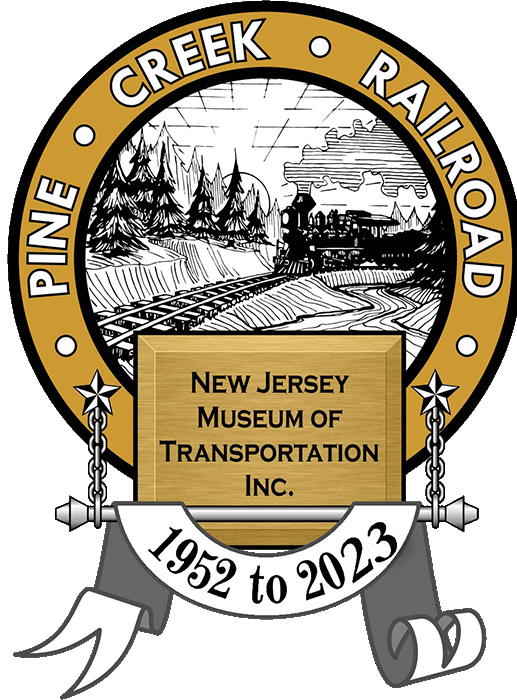A Brief History of the New Jersey Museum of Transportation and the Pine Creek Railroad
It all began in a sand pit.
Around 1950, under pressure to convert to diesel power, the Raritan River Sand Company in Nixon, New Jersey, contemplated scrapping their steamers. Meanwhile, railroad enthusiasts James Wright (who worked for his family's sand company) and Jay L. Wulfson (manager of the Mayfair Dress Company in South River, New Jersey) formed Wright & Wulfson, Inc., and bought a Baldwin 0-4-0T to become Pine Creek No. 1.
Together with Pierre "Pete" Rasmussen (an agent for the Central Railroad of New Jersey), Wright & Wulfson founded the Pine Creek Railroad Museum in 1952. They purchased a 2.5-acre plot of commercial real estate on Route 9 in Marlboro Township, New Jersey, a few miles north of Freehold, and set about building a little narrow-gauge railroad using rail rescued from abandoned sand pits. After laying some track and constructing a small engine house, they began attracting other railroad enthusiasts willing to volunteer their time, and eventually they cobbled together a passenger coach and ran the railroad as an amusement attraction.
In 1956 Wright & Wulfson were then contracted to create a similar amusement ride at Cowboy City on Route 33 in Howell, New Jersey, and they set up a separate company called the Cranberry Creek Railroad, Inc., to build and operate the Copper Creek Railroad, comprising a 1,700-foot loop of track. No. 1 was shipped to the Copper Creek Railroad, but failed her annual state boiler exam, so they purchased another locomotive from Raritan River Sand-this time a Porter 0-4-0T saddle tanker-as a replacement.
Unfortunately, Cowboy City started having difficulty paying their creditors, and when they closed, all of the rolling stock was returned to the Pine Creek Railroad Museum. By then, Pine Creek had leased Ely-Thomas Shay No. 6 from owner Edgar Mead. The volunteers had also formed the New Jersey Museum of Transportation, Inc., a new not-for-profit organization. Meanwhile, the Cranberry Creek Railroad Company had taken ownership of the standard gauge Middletown and New Jersey Railroad in Middletown, New York.
And so the founders of Pine Creek and the volunteers who helped run it were destined to part ways. Pine Creek No. 1 was sold to Disneyland in California, whereas Copper Creek No. 3 and the two homemade coaches became the property of the Busch Woodlands Museum in Cooperstown, New York. Wulfson and Rasmussen then donated all of the remaining rolling stock and other assets to the New Jersey Museum of Transportation.
The museum had already been contemplating relocating to another location so as to expand their operations, but in 1962 moving became critical when, owing to a land reassessment, they were hit with a 300% property tax hike, which threatened to consume upwards of 70% of the museum's annual revenue. Unsuccessful in their bid to appeal their case with Marlboro Township, the museum finally found their new home: Allaire State Park in Wall Township, Monmouth County.
A charter was drawn up in December 1962 that formalized the creation of the not-for-profit Pine Creek Railroad Division of the New Jersey Museum of Transportation, Inc. The scope of the charter was deliberately broad so that they could incorporate other forms of transportation into the museum in the future, if they so chose. Their ambitious plans for the railroad itself included a two- to three-mile dogbone that was to feature a 30-foot high, 100-foot long trestle across a gully.
Work on the new roadbed began in 1963, making use of rail provided by Trooper Alden T. Cottrell, Chief of the Bureau of Forests and Parks, who obtained it from an unused siding that ran to the county jail. While a search was reportedly undertaken to find an existing trestle that could be moved, no further mention of the bridge can be found, and when the golden spike was driven on 20 June 1964 (with New Jersey Governor Richard Hughes performing the honors, right), the loop of track had shrunk to just a little over half a mile. At this point the process of moving everything to the new site was yet to be completed; the original land had been sold on 14 October 1964, and all remaining railroad artifacts had to be removed by mid-1965, which included the ex-Jersey Central passenger station from Freneau in Aberdeen Township, and Raritan Copper Works No. 9, among many other artifacts.
By 1967 the Pine Creek Railroad had come a long way: the station was refurbished, a new enginehouse was built, a Raritan River caboose was converted into living quarters for the resident machinist, the Railroadiana shop opened, a small diesel was acquired, and the Ely-Thomas Shay was running the loop, as reported by the NJMT Newsletter editor at the time, Theodore F. Gleichmann. Thanks to the efforts of many volunteers, the railroad has been in continuous operation ever since, and the Museum has featured an ever-changing roster of unique and historically significant railroad artifacts.
